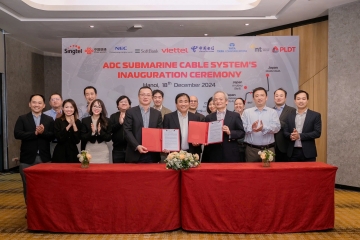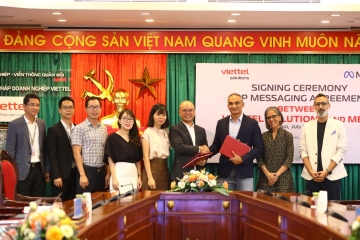With 36,000 BTS, Viettel promises 4G speeds to be truly 4G
At the time of launch, Viettel's 4G network will have 36,000 stations. This will only be done in 6 months to quickly provide services to our citizen, prepare the infrastructure to welcome the 4th Industrial Revolution. Until this moment, after 4 months, Viettel has built and broadcasted up to nearly 70% of our target plan. Thus, just over 4 months of ramming, 4G network of Viettel has been widely spread in all provinces and cities across the country, covered 704 districts, equivalent to nearly 99% of all districts in Vietnam. By April of 2017, we are sure to have installed 36,000 4G stations and are ready to put our service into operation.
.jpg)
Mr. Tao Duc Thang-Deputy General Director of Viettel Group
The most outstanding point in the campaign of deploying 4G is the quick timing, ie, in just 6 months, Viettel has built a 4G network infrastructure that is larger than the 3G infrastructure (which was done in 8 years). Viettel will cover 95% of the population in Vietnam, even in remotely areas.
This is not just infrastructure for business, but we understand that this is the infrastructure that will help the nation to access the internet broadband. The Fourth Industrial Revolution is not a revolution in technology, but a revolution in applications. Anyone who sees an opportunity will win. Viettel builds extensive 4G network infrastructure to help our 90 million people in Vietnam who can see the opportunity. It is because of such vision that the investment plans, we even put ourselves in a state of emergency. All priorities are for the 4G project.
In addition, to be able to deploy quickly, it is necessary to mention the preparation long before the installation of infrastructure. Currently, Viettel is the enterprise with the largest optical fiber infrastructure in Vietnam, the total length of optical cable of Viettel in Vietnam market is enough to wrap more than 8 rounds around the world, fiber has reached the commune. That is an infrastructure for us to deploy 4G.
We have experienced 4G deployments in six overseas markets (Cambodia, Laos, Burundi, Haiti, Peru, East Timor), so the deployment of nearly 36,000 of 4G stations in six months is like a miracle. Based on a long-term vision, a careful calculation, a determination of both a system and an elite, experienced team. Therefore, this achievement is not without foundation.
.jpg)
Mr. Tao Duc Thang at the 4G launching ceremony in Peru
Currently, MIC is licensing mobile networks to deploy 4G in the 1800 MHz band. To make sure the 4G service is truly at 4G speed, all operators who is joining the force need to ensure the "wide, deep and large" factors to ensure speed for customers - this is also the reason that Viettel chose to invest in new stations. If there are only few 4G broadcast stations and no deep coverage then 4G speeds may be just 3G + - and that is what the prime minister fears. However, with 36,000 of 4G broadcast stations connected by fiber optic cable and the same investment and deployment strategy, "làm đến đâu tốt đến đó" we confidently assert with the Prime Minister that 4G of Viettel will really be 4G rather than 3G +. With the current 4G deployment, 4G speeds are 6-10 times faster than 3G.
On the technical terms, with the current 1800 MHz band, there is a fundamental guarantee for 4G deployment. However, when 4G users increase, the speed will naturally be affected. We also calculated that the capacity will be available when users increase, but at the same time, we are seeking MIC to consider adding 2.6 GHz band for networks to ensure the best quality of service.
Typically, operators will choose to only deploy 4G in urban areas, so they will gradually invest from urban to rural areas. However, Viettel, with our vision, did not want Vietnam to miss the 4th industrial revolution, so we decided to invest in large scale, with extensive coverage to ensure the best. With 4G, Viettel is determined to conquer the great desire to upgrade Vietnam's telecoms rankings on the world's telecommunication map as well as put forward telecommunications infrastructure in preparation for the country's development and solidarity.




